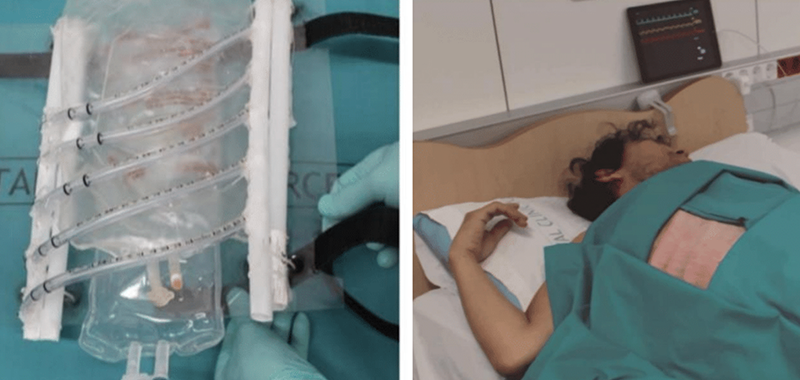
Thoracostomy is indicated in life-threatening situations such as tension pneumothorax or massive hemothorax, and usually performed in the emergency department and intensive care units (ICUs). These clinical situations are relatively uncommon and extremely stressful. Besides, this invasive procedure can result in potentially lethal complications such as bleeding and damage to the lungs, heart, or trachea, leaving little margin for training in routine clinical practice1.
Simulation is the best way to realistically portray this emergency situation to enable the necessary skills to be acquired in a safe environment2. A wide variety of commercially available manikins, phantoms, and models can be used for training chest-tube insertion. All of them have certain advantages and drawbacks. Although many of the marketed models provide a high degree of fidelity, their main disadvantage is their high cost3-5.
In this context, our group developed a low-cost, realistic hybrid model for training in chest-tube placement in emergency scenarios. Most of the material used to construct this model was obtained from expired hospital material and waste products. Thorax structure was performed using a plastic sheet joined to several orotracheal tubes simulating the ribs, and a 3000-mL plastic bag was placed inside the structure as the pneumothorax chamber. Finally, the structure was covered with a pigskin and underlying tissue piece to simulate chest wall´s skin, subcutaneous tissue and muscle. The model can be used as a phantom in workshops for developing technical skills as well as in simulation scenarios carried out with hybrid models (phantom attached to an actor). Fully description of the design and elaboration of the model can be consulted in the published article: https://pubmed.ncbi.nlm.nih.gov/36892559/
We also evaluated the applicability and usefulness of this model in realistic simulation workshops for different training scenarios for professional health care teams, medical students, and experts in chest-tube placement. The phantom design presented no difficulties that required changes to the model in any of the training sessions. Both the experts and the participants in the workshops completed a survey designed to evaluate the technical fidelity of the model and its usefulness for achieving the workshop’s learning objectives. The survey included items related to technical fidelity and items related to its usefulness for learning. Mean ratings for the appearance and the haptic quality of the model ranged from 8.6 to 9.8 (0–10 scale) without statistically significant differences among groups. All groups rated the usefulness of the model for achieving the learning objectives highly and the usefulness of the hybrid model (phantom on an actor and monitoring system) very highly. A total of 42 open comments were received. Many of these praised the usefulness of the clinical simulation scenario in which the phantom was mounted on an actor, stating that it made the procedure realistic.
In our opinion, this reusable, transportable, and highly realistic thoracostomy simulation model is an attractive alternative to commercial counterparts for learning and maintaining chest-tube insertion skills. It is especially promising for institutions with budgetary restraints or learners residing in remote rural areas without access to high-fidelity simulators.
Written by the Barcelona Team
- Jones CW, Rodriguez RD, Griffin RL, et al. Complications associated with placement of chest tubes: a trauma system perspective. J Surg Res 2019;239: 98–102.
- Hertz P, Jensen K, Abudaff SN, et al. Ensuring basic competency in chest tube insertion using a simulated scenario: an international validation study. BMJ Open Respir Res 2018;5(1):e000362.
- Bohnen JD, Demetri L, Fuentes E, et al. High-fidelity emergency department thoracotomy simulator with beating-heart technology and OSATS tool improves trainee confidence and distinguishes level of skill. J Surg Educ 2018;75(5):1357–1366.
- Bengiamin DI, Toomasian C, Smith DD, Young TP. Emergency department thoracotomy: a cost-effective model for simulation training. J Emerg Med 2019;57(3):375–379.
- Crawford SB, Huque YI, Austin DE, Monks SM. Development and review of the CHEST tube high-feedback educational simulation trainer (CHEST). Simul Healthc 2019;14(4):276–279.



